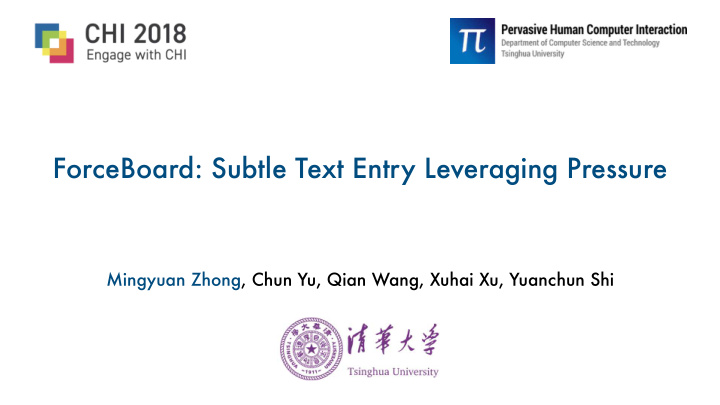



ForceBoard: Subtle Text Entry Leveraging Pressure Mingyuan Zhong, Chun Yu, Qian Wang, Xuhai Xu, Yuanchun Shi
Traditional text entry methods Physical Touch keyboards input or buttons Wet Limited screen device size
ForceBoard: Pressure-based text entry • One-dimensional • Using pressure as the only channel for text entry • Text entry with subtle motion
1x
0.3x
Outline • Pilot Study: Making design decisions • User Study 1: Error model of pressure control • Design and Implementation • User Study 2: Performance evaluation • Applications and Limitations
Pilot Study: Making design decisions • Keyboard Layout: A-Z; QWERTY; ENBUD • Cursor Width: 1, 3, 5, 7, 9 • Selection Method: Dwell and Quick Release An example condition for the pilot study - Keyboard layout: A-Z - Cursor width: 5 - Selection Method: Dwell (not illustrated)
Keyboard Layout • Keyboard layouts: - abcdefghijklmnopqrstuvwxyz (Alphabetical A-Z) - qwertyuiopasdfghjklzxcvbnm (QWERTY) - enbudjcoflyqthvigmxrzpkwas (ENBUD) • Users were not familiar with the QWERTY or ENBUD layout in one- dimension • Users preferred the alphabetical layout
Cursor Width • Tested 1, 3, 5, 7, 9-letter-wide cursors • Users reported difficulty controlling the cursor for widths < 5 • Simulation with a 10,000-word language model 50% show that a 9-letter-wide cursor would lead to 40% too much conflicts 30% • Chose cursor widths 5 & 7 20% 14.5% 10% 3.6% 0.5% 0% 5 7 9
Selection Method: Dwell and Quick Release
Dwell Intended Cursor target
Dwell Intended target
Dwell Intended target
Quick Release Intended target
Quick Release Intended target
Quick Release Intended target
Selection Method: Dwell vs. Quick Release • Dwell: holding pressure for 300 ms selects the target • Quick Release: releasing pressure selects the target • Users preferred Quick Release and considered it to be much faster
Selection Method: Dwell vs. Quick Release • Dwell: holding pressure for 300 ms selects the target • Quick Release: releasing pressure selects the target • Users preferred Quick Release and considered it much faster • In-contact Quick Release: keep the thumb in contact with the screen after selecting each letter
Pilot Study: Summary • Alphabetical one-dimensional keyboard layout • Cursor width should be 5 or 7 • In-contact Quick Release
Outline • Pilot Study: Making design decisions • User Study 1: Error model of pressure control • Design and Implementation • User Study 2: Performance evaluation • Applications and Limitations
Study 1: Error model of pressure control • Wizard of Oz approach • Cursor widths 5 or 7 • Random 3-letter sequences
Study 1: Error model of pressure control • Offset: distance between the cursor location at Quick Release and the intended target center Intended Cursor target o ff set (+) • Offset is position when the cursor overshoots the target position
O ff set
Error model of pressure control • Distribution of Offset • Miss rate: percentage of pressure input where users completely overshot or undershot the target letter - 5-letter-wide cursor: 7.7% missed - 7-letter-wide cursor: 5.8% missed • Users attempted to release pressure and move the cursor to the intended position
Outline • Pilot Study: Making design decisions • User Study 1: Error model of pressure control • Design and Implementation • User Study 2: Performance evaluation • Applications and Limitations
Interaction Design • One-dimensional keyboard regions • Two cursors to help with overshooting target position
• Selecting a candidate word: tap to select the next one; long press to select the previous one • Inputting the word “force” r o e c f tap tap tap
Word prediction • Statistical decoding: error model of pressure control + unigram language model (10,000 words) • User input a sequence of pressure I = p 1 p 2 …p n • Suppose pressure applied for each letter to be independent • OOV words can be entered by selecting each individual letter
Outline • Pilot Study: Making design decisions • User Study 1: Error model of pressure control • Design and Implementation • User Study 2: Performance evaluation • Applications and Limitations
User Study 2: Performance evaluation • 12 users with no experience with pressure-based input • A character-level session and a Word-level session • Users entered two phrases as a warm-up before each session • Character-level session: 2 phrases × 4 blocks • Word-level session: 10 phrases × 4 blocks
Results • Error rates - Uncorrected: 1.1% for character-level; 0.47% for word-level - Corrected: 2.0% for character-level; 1.8% for word-level • Text entry rate - Character-level: average: 4.24 wpm last block: 4.42 wpm - Word-level: average: 11.04 wpm last block: 12.80 wpm
Outline • Pilot Study: Making design decisions • User Study 1: Error model of pressure control • Design and Implementation • User Study 2: Performance evaluation • Applications and Limitations
Applications • When device form-factor is limiting • When finger movement is not desired • When capacitive touchscreens are infeasible • When used with a separate display
Limitations and future work Limitations • Slower than touch-based keyboards • Requires continuous visual attention Future work • Longitudinal study on learning, fatigue, and mental stress • Investigate rate control instead of position control • More sophisticated language models
Summary • Pressure as the main input channel One-Dimensional Handwriting: Inputting Letters and Words on Smart Glasses (CHI ’16) • Subtle thumb movement https://dl.acm.org/citation.cfm?id=2858542 • Modeled continuous pressure control Understanding the Uncertainty in 1D Unidirectional Moving Target • 11 wpm after 10 minutes training Selection (CHI ’18) https://dl.acm.org/citation.cfm?doid=3173574.3173811 Link to this paper https://dl.acm.org/citation.cfm?id=3174102 Tsinghua HCI Group http://pi.cs.tsinghua.edu.cn My email jason.nkg@gmail.com
Recommend
More recommend